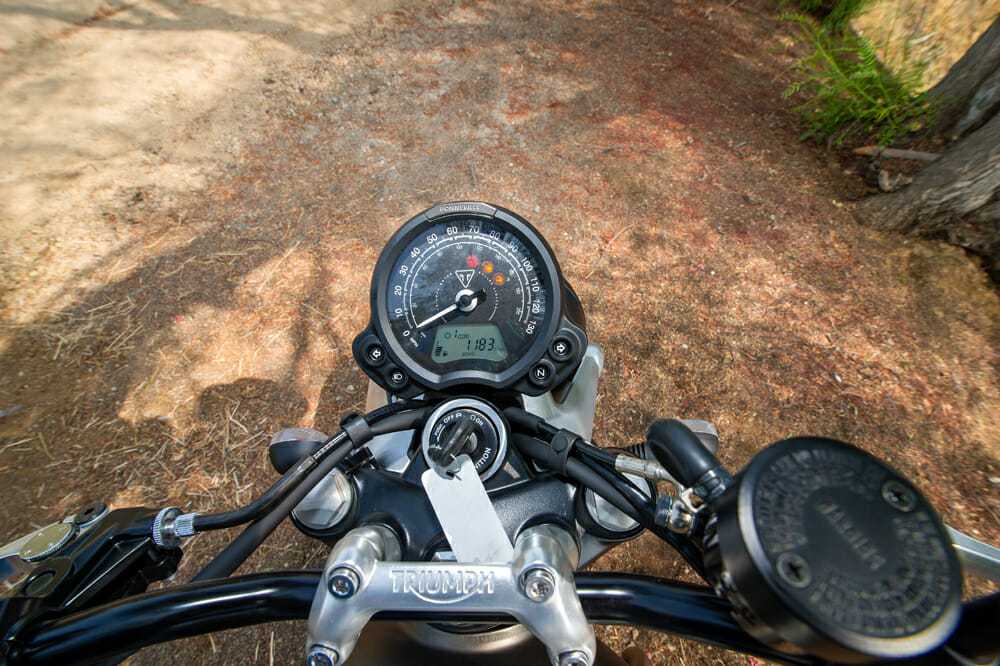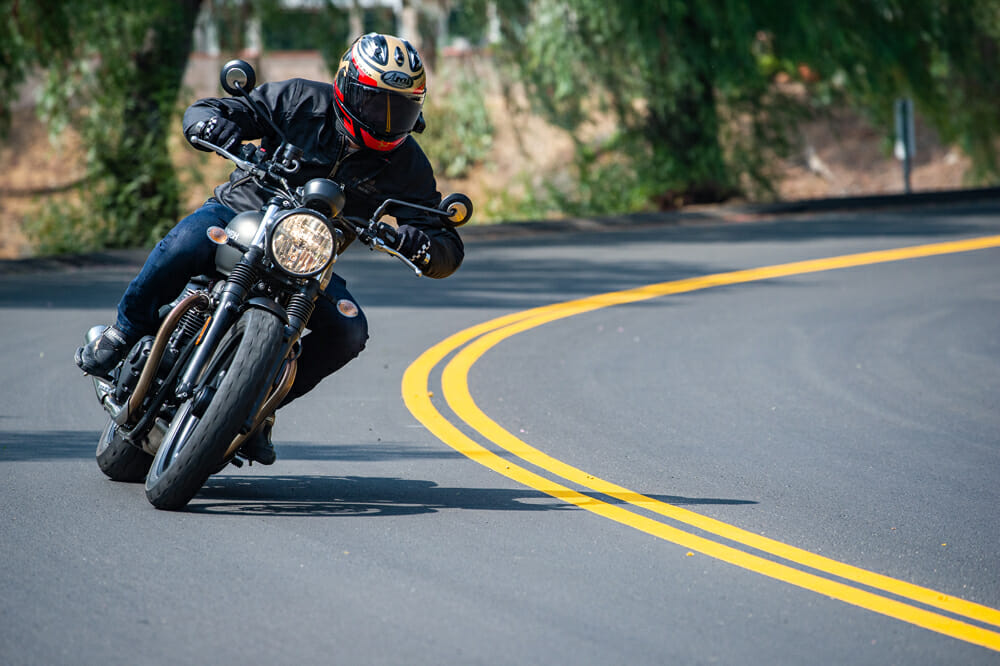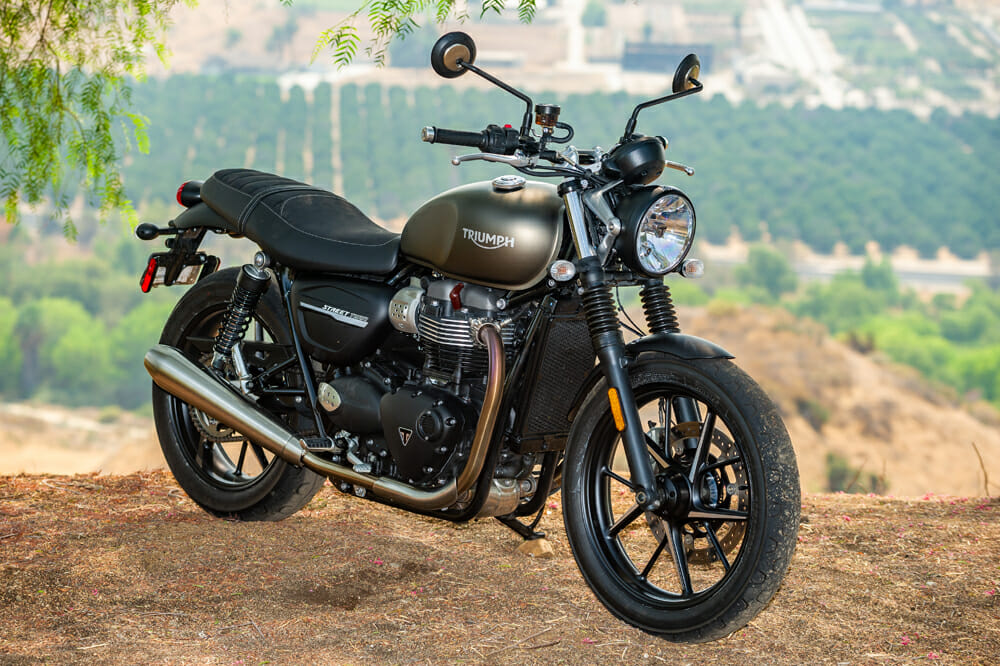Rennie Scaysbrook | October 22, 2020
Sometimes all you need is a British twin and nothing to do for an afternoon.
 Classy, fun, good-looking. The Triumph’s not bad, either.
Classy, fun, good-looking. The Triumph’s not bad, either.
Photography by Kit Palmer
Let’s face it: 2020 has been nothing short of a feces-fueled dumpster fire. It has continually thrown us into disarray—businesses and lives have been ruined, a continual state of fear is perpetuated by those in authority, and we’re almost always exposed to the worst humanity has to offer.
What 2020 has also done is highlight the things and people that really matter. For me, that’s my family and the peace I find when I strap my helmet on and simply go for a ride, with no motive other than to get away from it all.
Simplicity is thus extremely important to me, which is where this week’s test bike of the Triumph Street Twin comes in. The Triumph is by no means a simple bike—it’s a modern machine with all the complexities that go with it—but the aurora it exudes is simple.
 Stripped back good times. The fit and finish on the Street Twin is excellent.
Stripped back good times. The fit and finish on the Street Twin is excellent.
Just get on and ride.
The Street Twin’s character is from another age, taken from when the original Triumph Bonneville lit the biking fuse under a generation growing up in the hippie times of the 1960s. The first Triumph Bonneville is one of the most important motorcycles ever created and was responsible for a large portion of sales in the last years of Britain’s motorcycle dominance as the Japanese manufacturers slowly gained ground. It’s no wonder then this Street Twin channels the legend of the original in such a faithful manner. What worked back then clearly still works now.
That being the case, Triumph isn’t just letting the Street Twin bring in the dosh without going to work on it. This year sees the fitting of the High Torque 900cc parallel-twin motor, with power up a claimed 18 percent at 64 horsepower at 7400 rpm, although torque itself remains the same at 59 lb-ft at 3800 rpm.
 Old-school clocks have minimal information, especially given the plethora of info you can get out of a Speed Twin.
Old-school clocks have minimal information, especially given the plethora of info you can get out of a Speed Twin.
That number hints more at what the Street Twin is all about. The 270° crank layout, mixed with the beautifully finished twin exhausts that exit under the twin rear shocks and that abundant low-rpm torque, offer a casual and thoroughly enjoyable riding experience.
I had just hopped off a Ducati Superleggera V4 the week before I took delivery of the Street Twin—two bikes that couldn’t be more diametrically opposed if they tried—and the Triumph was just so inviting after the boxing match the Ducati represented. Every time I fired it up in the garage, I was met with that low, booming bark of the parallel-twin, and I found myself sneaking off for a quick strap up Santiago Canyon Road near my place just for the joy of it.
 That 900cc Bonnie motor is a gem and has one of the best-sounding notes you can buy.
That 900cc Bonnie motor is a gem and has one of the best-sounding notes you can buy.
 The seat is finished in a lovely suede.
The seat is finished in a lovely suede.
The way the Triumph delivers its go from the 900cc motor is creamy smooth. I’d not call this a beginner’s bike, yet it would suit riders with lower levels of experience over some of the higher performance machines in the Triumph range.
There are two riding modes of Street and Rain, and the motor is matched to a five-speed gearbox I’d admittedly like to have seen a sixth gear in. The shift itself is light and direct, especially when used at a casual pace. Up the speed and urgency of your riding and the gear shift can get a little notchy, which is a gentle reminder to take things a bit slower on the Triumph.
 The Street Twin is quite a compact machine and will suit riders around 5’10.”
The Street Twin is quite a compact machine and will suit riders around 5’10.”
The same can be said for the single-disc front brake. Gripped by a four-piston caliper, the braking is adequate at normal traffic speeds but repeated high-speed, heavy braking will wear the system out, with brake fade slowly creeping in. It’s certainly not a deal-breaker, especially as I love the look of the single-disc front wheel, but just something to be mindful of.
You only get preload adjustment on the shock, with no adjustability on the fork, and I’ll admit I’m probably a little heavy at 190 pounds for the stock suspension. If you’re 20 pounds less (and about 5’10”), the suspension action should be pretty much bang on.
 Suspension performance is adequate but not really up for attacking the corners at high speed.
Suspension performance is adequate but not really up for attacking the corners at high speed.
That being said, the comfort of the Triumph is very good. The seat is beautifully appointed in a suede finish, and the paintwork of the 1960’s-style tank is extremely well executed. However, it was annoying to have to wait a good two minutes before the LCD dash would update with a full tank at the gas station.
Regardless, there’s a nice, quality feel to the Street Twin, and it’s different to what’s on offer from Japan or Italy or Germany.
This is a quintessentially British motorcycle, unapologetically so. At a claimed 436 lb of dry weight, it’s not the lightest in the category but (in my mind) certainly the most stylish.
The Street Twin offers easily accessible riding, accompanied by one of the best soundtracks ever created in the thumping parallel-twin. It’s a versatile, classic ride, a (dare I say it) simple ride, which is one of the reasons I love it. CN

2020 Triumph Street Twin Specifications
|
|
| MSRP: |
$9,300 |
| Engine: |
Liquid-cooled, 8-valve, SOHC, 270° crank angle parallel-twin |
| Fueling: |
EFI |
| Displacement: |
900cc |
| Bore x stroke: |
84.6 x 80mm |
| Power (claimed): |
65 hp at 7500 rpm |
| Torque (claimed): |
59 lb-ft at 3800 rpm |
| Transmission: |
5-speed |
| Clutch: |
Wet multi-disc |
| Chassis: |
Tubular steel |
| Front suspension: |
KYB 41mm fork, non-adjustable |
| Rear suspension: |
KYB twin RSUs, with adjustable preload |
| Front-wheel travel: |
4.7 in. |
| Rear-wheel travel: |
4.7 in. |
| Front brake: |
Single 310mm floating disc, Brembo 4-piston fixed caliper, ABS |
| Rear brake: |
Single 255mm disc, Nissin 2-piston floating caliper, ABS |
| Front tire: |
100/90-18 in. |
| Rear tire: |
150/70-17 in. |
| Seat height: |
29.9 in. |
| Wheelbase: |
55.7 in. |
| Steering head angle: |
25.1° |
| Fuel capacity: |
3.2 gal. |
| Weight (dry, measured): |
436 lbs. |
